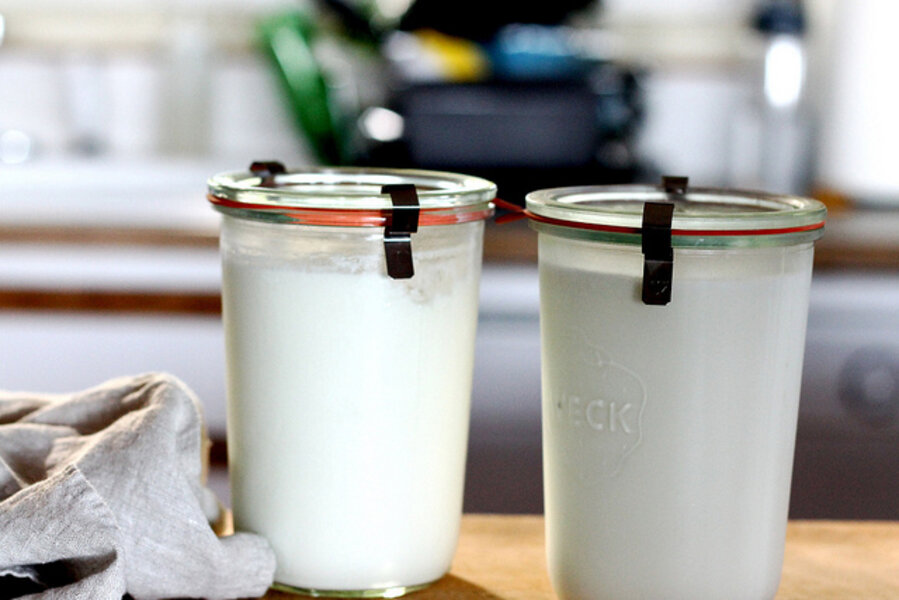Creamy homemade yogurt
Loading...
As I've said many times, cooking is creating.
My medium isn't acrylics, oils, metal, or wood, but the possibilities in my refrigerator and the pure joy of transforming something.
That's why I bothered to make yogurt. It used to be that you couldn't find a tub of great yogurt unless you drove to a natural foods store in Southern California. My parents used to make it in their bathtub in the 1980s. I should ask my mom exactly what method they used, but I remember the bathtub being unusable for hours at a time because yogurt-making was in progress. I remember Mom driving all over Timbuktu looking for specialty ingredients in small-town Bellingham, Wash., like Tamari sauce, dried chiles, fresh herbs, saffron, artisan bread. Or good yogurt that wasn't full of sugar, filler, and thickeners.
These days, of course, standing in the yogurt aisle at any decent store can be dizzying. Whole milk or nonfat? Greek or European style? Cow's milk or goat's milk? Sweetened or plain? There's no lack of choices and certainly no imperative for getting out one's candy thermometer and waking in the middle of the night to transfer precious jars to the fridge.
But forgive me if I WANTED to, in the same way I want to make a jar of preserves just for the pleasure of it. Or make pizza dough though Trader Joe's is really just as good. (Honestly, it is. Heat up that pizza stone and you'll think, "Why did I bother?!")
I used to have a garage sale yogurt maker, a little tray that held jars. Plug the tray in, and it kept the milk at a steady, low temperature so it would culture and thicken up. I tossed it in the Goodwill bin when we moved for two reasons: (1) It took up too much room and (2) I never liked the way it turned out, sort of curdled and overly sour.
I've been obsessed with Liana Krissoff's book Canning for a New Generation, and she jokes about "preserving milk" by turning it into yogurt. And buying the cheapest, almost expired milk to do it with. I splurged and bought organic whole milk, but old on-the-brink stuff is fine. Her method is SO EASY! The only special equipment you need is a candy thermometer (which has a million other uses, so I recommend getting one.)
I woke up in the middle of the night last night, aware that the prescribed "8 to 10 hours" had passed. I swung my feet onto the floor, padded into the kitchen, and opened the little cooler I had been using. Divine perfection. The yogurt had set up perfectly, and was more smooth and creamy than anything I'd ever made or purchased. I stuck it in the fridge and had yogurt dreams until morning. I mixed it with a spoonful of preserves (also from Liana's book) and felt very proud of myself. No bathtub required.
Homemade yogurt
1/2 gallon milk (low-fat or full-fat!)
2 tablespoons plain yogurt with active cultures (important: no pectin or other ingredients besides milk and active cultures!)
1. In a large saucepan, heat the milk over medium high heat to 170 degrees F. on a candy thermometer, stirring occasionally. Remove from the heat, set the pan in a larger bowl of ice water, and let cool to 110 degrees F., stirring occasionally.
2. Meanwhile, fill two glass quart jars with hot water to warm them; pour out he water. When the milk has cooled to 110 degrees F., ladle a little of it into a small bowl and whisk in the yogurt. Whisk the mixture back into the milk in the saucepan, then pour the mixture into the warmed jars and put the lids on tightly.
3. Set the jars in an insulated cooler (I used my insulated lunch tote), wrapping them with towels and tucking one or two bottles of hot water into the cooler with them if necessary to fill up space. Basically, make the jars cozy. Set the cooler in an out-of-the-way spot for 8-10 hours, or overnight, and be careful not to jostle or disturb it as that will interfere with the fermentation.
4. The milk will thicken and become yogurt, and it's best to refrigerate it for a couple hours after you pull it from your cooler. In all likelihood your yogurt will be plenty thick, but if you want it even thicker, put it in a sieve lined with a couple layers of cheesecloth and let it drain over a bowl in the fridge for a few hours. I didn't do this, as I couldn't stand to see my beautiful yogurt reduced by 30 percent (or more!) and I liked the looser consistency.








